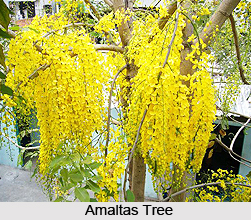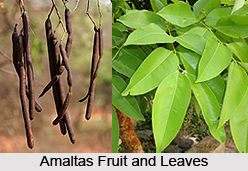 Amaltas, known as the golden shower tree and by other names, is a flowering plant in the family "Fabaceae". Amaltas is a tree which is available with small or medium size. This tree is generally evergreen and it grows up to a height of 24 m. This species is a native to south-eastern parts of Asia. But today, this plant is widely distributed in the tropics where it is mainly cultivated for decorative purposes. It is also the state flower of Kerala in India and of immense importance amongst the Malayali population. It is a popular ornamental plant and is also used in herbal medicine. Found generally in all parts of India, it is cultivated in mixed deciduous forests and certain hilly tracts having an altitude of 1200 m in the outer Himalayan region. This tree is also commonly found in the central and southern parts of India and in the Gangetic valley.
Amaltas, known as the golden shower tree and by other names, is a flowering plant in the family "Fabaceae". Amaltas is a tree which is available with small or medium size. This tree is generally evergreen and it grows up to a height of 24 m. This species is a native to south-eastern parts of Asia. But today, this plant is widely distributed in the tropics where it is mainly cultivated for decorative purposes. It is also the state flower of Kerala in India and of immense importance amongst the Malayali population. It is a popular ornamental plant and is also used in herbal medicine. Found generally in all parts of India, it is cultivated in mixed deciduous forests and certain hilly tracts having an altitude of 1200 m in the outer Himalayan region. This tree is also commonly found in the central and southern parts of India and in the Gangetic valley.
Different Names of Amaltas
In English this Indian Medicinal Plant is known as "Golden Shower" or "Indian Laburnum"; in Hindi, it is referred to as "Amaltas"; in Sanskrit as "Aragvadha"; in Malayalam as "Vishu Konnai"; in Tamil it is known as "Arakkuvadam" or "Konrai" and so on. The botanical name of Amaltas is "Cassia Fistula" and it belongs to the Gulmohur family.
Characteristic Features of Amaltas
Amaltas is a medium-sized tree, growing to 10-20 m tall with fast growth. Amaltas tree possesses grey coloured smooth barks spreading out in some small, woody scales up to a thickness of 1.5 cm. The leaves of this tree is paripinnate, usually 20 to 40 cm in length, petioles and rachis are glandless, leaflets are 3 to 8 pairs, markedly stalked, 5 to 15 cm in length and 3.5 to 9 cm in width, ovate or oblong, peak acute, base acute to wedge shaped, dressed with silvery pubescence during the younger period. The flowers of Amaltas are bright yellow in colour, axillary, pendulous, many-flowered lax racemes of 10 to 40 cm in length; 5 sepals, pubescent, green, ovate or oblong-obtuse; 5 free corolla, short-clawed, sub-equal and reddish-veined petals. The fruits of this tree are black or dark brown in colour, having a pendulous or cylindrical shape and it is usually 25 to 30 cm long. The diameter of the fruit or pod is 1.5 to 3 cm in diameter. The seeds of Amaltas are smooth, flat, small, light brown in colour. There are around 40 to 100 seeds in a pod or fruit, set in a sweetish black pulp. Flowers in this tree bloom from the months of April till October and the fruits of this tree are ripe from the months of December till April as per the local environment.
Medicinal Values of Amaltas
 The dried pulp and pods of Amaltas are considered precious for their laxative properties. The bark and pods demonstrate antiviral activity. The extraction of the pods is prescribed for common fever and pneumonia. Swelled neck as a result of severe cold can be treated by applying heated pods. The pulp is regarded as a safe purgative, highly recommended for children and pregnant women to relieve liver upsets and biliousness. The same is also used externally for the treatment of rheumatism and gout, and it may also be safely used as an analgesic. It is also used for the treatment of black water fever, malaria, leprosy and diabetes. The slightly sweet seeds of Amaltas contain carminative, laxative, cooling and antipyretic properties. The seeds are used to give relief from constipation and for the treatment of jaundice, skin diseases, biliousness and swollen throat. Intestinal worms are cleared by the use of the powdered whole seeds of Amaltas. In Ayurvedic medicine, it is used for the treatment of diseases of the skin like leucoderma and eczema. The extraction or powder of the bark of Amaltas is prescribed for treating syphilis and heart disease. The powdered wood is reportedly used for dysentery and its ash is used as a caustic to promote healing of open abscesses.
The dried pulp and pods of Amaltas are considered precious for their laxative properties. The bark and pods demonstrate antiviral activity. The extraction of the pods is prescribed for common fever and pneumonia. Swelled neck as a result of severe cold can be treated by applying heated pods. The pulp is regarded as a safe purgative, highly recommended for children and pregnant women to relieve liver upsets and biliousness. The same is also used externally for the treatment of rheumatism and gout, and it may also be safely used as an analgesic. It is also used for the treatment of black water fever, malaria, leprosy and diabetes. The slightly sweet seeds of Amaltas contain carminative, laxative, cooling and antipyretic properties. The seeds are used to give relief from constipation and for the treatment of jaundice, skin diseases, biliousness and swollen throat. Intestinal worms are cleared by the use of the powdered whole seeds of Amaltas. In Ayurvedic medicine, it is used for the treatment of diseases of the skin like leucoderma and eczema. The extraction or powder of the bark of Amaltas is prescribed for treating syphilis and heart disease. The powdered wood is reportedly used for dysentery and its ash is used as a caustic to promote healing of open abscesses.
The leaves possess laxative and anti-periodic, and are used in the treatment of piles, externally for skin eruptions, ulcers, wounds, prurigo and pruritis. However, a paste of the fresh leaves is used internally by central Orissa tribal women to cure amenorrhoea. In the north-eastern parts of the state of Karnataka, the roots of Amaltas mixed with goat milk are given in little doses regularly for the treatment of breast diseases. The aqueous extract of the bark of the root shows anti-inflammatory activity. The edible flowers of this tree possess astringent, febrifugal, purgative and anti-bilious properties.











